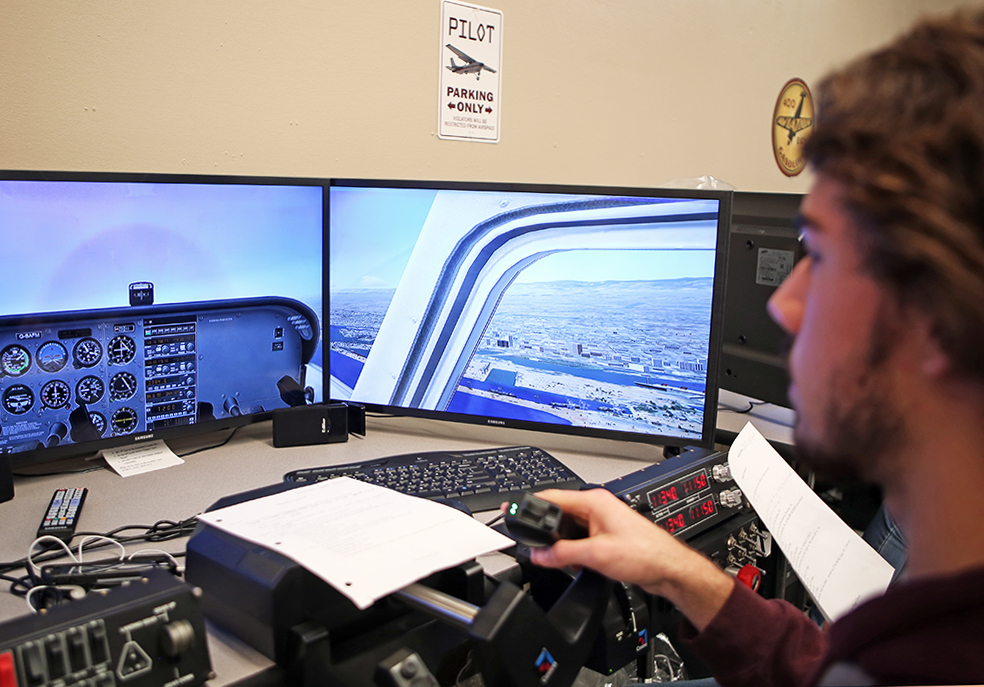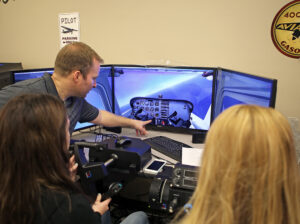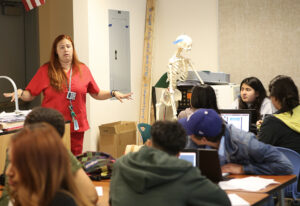
Black teachers: How to recruit them and make them stay

Lessons in higher education: What California can learn

Keeping California public university options open

Superintendents: Well-paid and walking away

The debt to degree connection

College in prison: How earning a degree can lead to a new life

Tenth-grader Ryan Streckfus glanced over the gauges on the control panel as he carefully lifted the steering wheel, hoping to keep his aircraft from stalling in the sky over the Long Beach harbor.
“Heading is now 150. Elevation is climbing back up to 3,000 feet. I’m back in control,” he said, from a flight simulator inside the aviation career pathway at Canyon High School in Anaheim where he’s training to become a pilot.
The program, the only one of its kind in the state, is part of a career technical education boom across California. As record numbers of high school students are applying to state colleges and universities, more are also receiving hands-on training in high-demand technical careers even before they earn their diplomas. The students, many beginning in the 9th grade, are in career pathways learning job skills alongside professionals in fields including aviation, health care, civil engineering, fashion design, tourism and new media.
These pathways, which integrate academics with real-world work experience, are being fueled by California’s unprecedented investment in career technical education. The state is pouring more than $1.5 billion over five years into programs aimed at establishing and strengthening partnerships between K-12 schools, community colleges and businesses to better prepare students for college and careers.
Over the past two years, the nearly $500 million Career Pathways Trust has awarded 79 school districts, county offices of education, community colleges and charter schools grants of $583,000 to $15 million each. The state last year also approved an additional $900 million in Career Technical Education Incentive Grants, which will be awarded to dozens of districts and other agencies over the next three years to accelerate the development of new programs. About a half dozen smaller grant programs are also helping drive California’s unprecedented growth in career technical education.

FERMIN LEAL/EDSOURCE TODAY
Instructor Stephen Smith helps students correct their plane’s altitude on a flight simulator during their aviation class at Canyon High in Anaheim.
“From a historical perspective, it’s great that there is such an investment in career technical education,” said Stephanie Houston, president of the California Association of Regional Occupational Centers and Programs.
“If we invest in a trained workforce, the jobs will come. So the areas that better develop the pipeline are the ones that are going to have a thriving economy,” she said.
However, lawmakers, educators and business leaders need to remember the $1.5 billion investment is one-time money, Houston said.
“These pathways are expensive. The ongoing costs are expensive,” she said. “We can’t say we’re done, or we fixed this, and then check this off our lists of priorities.
“Job markets are consistently changing. The biggest challenge is sustaining these programs as they try to keep up with the change.”
Canyon High received $150,000 as part of the state’s $5 million Specialized Secondary Programs grant in 2014 to start the school’s aviation pathway. About 50 students are currently learning on six flight simulators, each with three high-definition monitors, a yoke (steering wheel), a throttle, pedals and a computer loaded with flight simulation software that serves as the replica of the plane’s cockpit. The class also trains students in concepts in aviation and aerospace engineering. By the end of the two-year program, students are ready to take the written test for their pilot’s license, and can begin flying lessons in actual airplanes. Some students will even receive their license to fly before their high school diploma.
“If we invest in a trained workforce, the jobs will come. So the areas that better develop the pipeline are the ones that are going to have a thriving economy,” said Stephanie Houston, president of the California Association of Regional Occupational Centers and Programs.
Stephen Smith, a former commercial pilot and flight instructor who’s taught math at Canyon, started the program to help meet the growing demand for workers in these fields.
“The aviation industry is in desperate need of pilots. The maintenance and engineering sides are also feeling the pressure,” he said. “Places like United Airlines are now recruiting candidates at the high school level.”
Through the courses, students study for careers as commercial pilots, or in aircraft maintenance, air traffic control, airport operations and aerospace engineering. Students completing the program then have the option to pursue engineering, aviation or a similar degree in college, or they can take more vocational courses in community college or through industry training programs that allow them to find jobs.
In Los Angeles Unified, which received a $15 million Career Pathways Trust grant, 15,000 high school students, or 8 percent of high school students districtwide, are enrolled this school year in one of the district’s 36 career pathways in fields including agriculture, construction, hospitality and tourism, fashion and design, art and new media, and construction.
At STEM Academy at Bernstein High in Hollywood, all 506 students enrolled in the school belong to a career pathway.
Students in the civil engineering pathway are studying this year alongside engineers with the city of Los Angeles as they plan Park 101, an ambitious proposal to build a park over a stretch of the 101 freeway in downtown Los Angeles. These students sit in on planning meetings while city staff reviews logistics of the project. Students also get to look over architectural designs and often provide some input.
“When I first started here as a freshman, I wasn’t sure civil engineering was the right fit for me,” said junior Benjamin Lahoy. “But after working on so many amazing projects, I realized this is what I want to do for a living.”

FERMIN LEAL/EDSOURCE TODAY
Teacher Amarryn Huelsman leads a class in the biomedical pathway at STEM Academy of Hollywood. Huelsman is also a certified emergency medical technician.
Students in STEM Academy’s medical pathway are spending part of their semester at the nearby Kaiser Permanente Hospital, where they help check patients in, observe surgeries, clean surgical equipment and perform other duties.
The program will help them decide what career in healthcare they want to pursue, said Esther Dabagyan, a teacher in the pathway.
“This experience gives students the opportunity to decide if they want to become surgeons, toxicologists, epidemiologists or lab technicians,” she said. “It helps them develop a passion for a career at an earlier age, and that motivates them to work hard towards pursuing that passion.”
The growing popularity of career pathways, along with the increased demand for programs that blend academics with real-world work experience, means districts across the state will continue adding a variety of pathways in coming years.
Los Angeles Unified has plans to add up to 39 new career pathways, more than double the number currently offered.
“We’ll soon be at the point where every high school offers a variety of pathways for students to choose from,” said Esther Soliman, the administrator for career technical education in Los Angeles Unified. “We’re seeing a reinvention of how high schools operate in the 21st century.”
Following are other examples of pathway programs statewide created over the past year:
Burbank Unified School District
Officials used $73,000 in Career Pathways Trust funding in December to purchase 23 3-D printers that are being distributed to district high schools as part of the digital manufacturing pathway. Students in the district’s digital media and design career pathway will use the printers starting this spring to build prototypes of projects they create, including small-scale models of architectural designs.
The 3-D printers “represent a key milestone in the enhancement of our digital manufacturing course offerings,” Burbank Superintendent Matt Hill said in a statement.
McBride High School in Long Beach Unified
Last year, McBride High School converted a classroom into a full-scale replica of a medical clinic in the school’s health and medical pathway, where students learn about 13 careers in the healthcare industry.

Credit: Courtesy of McBride High School
McBride High School’s medical pathway program includes a full-scale clinic with equipment provided by hospitals.
The school’s clinic includes six hospital beds, wheelchairs and diagnostic equipment. The clinic was created through a partnership between the district and Long Beach Memorial Hospital, whose medical staff serves as mentors for the high school students.
By their senior year, some students in the pathway will be eligible to apply for certification as emergency medical technicians or certified nursing assistants, meaning they would be able to work in those jobs after high school.
“Going through this program definitely sets you up to have a lot of choices after high school,” said Marisol Cervantes, a junior at the school. “It takes a lot of pressure off knowing that you can continue your education in college, or you can find a job that pays really well right out of high school.”
Mount Shasta High School, Siskiyou Union High School District
The school used $106,000 in Career Pathways Trust funds it received this school year to create the Manufacturing/Business Learning Center.
The program includes a welding pathway where students learn the trade inside a manufacturing lab equipped with a plasma cutter and 12 welding booths, with a curriculum designed by the American Welding Society.
Students also learn AutoCAD and Solidworks, engineering and computer-aided design software, which allows them to draft their projects before they build them in the lab.
Lindhurst High School, Marysville Joint Unified School District
The Culinary Arts program began last fall as part of a partnership with Yuba College. About 50 high school students are learning about the restaurant industry in a professional-grade kitchen funded with part of the $7.7 million in Career Pathways Trust funds awarded to a regional consortium of school districts and community colleges.
In the class, students learn different aspects of food preparation that will train them for jobs ranging from food servers to chefs. Students regularly cater school events and prepare meals for area charities.
Pleasant Grove High School, Elk Grove School District
The PGHS Digital Media Academy, a four-year video production pathway, was launched last fall with a $50,000 grant from the state’s Specialized Secondary Programs.
Academy students learn video production, editing, broadcasting and similar skills inside the campus’s fully functional television studio. They work with industry-standard software and hardware, and are mentored by professionals working at the KCRA television station in Sacramento.
The students produce weekly newscasts, talk shows and other programming aired on campus.

A grassroots campaign recalled two members of the Orange Unified School District in an election that cost more than half a million dollars.

Legislation that would remove one of the last tests teachers are required to take to earn a credential in California passed the Senate Education Committee.

Part-time instructors, many who work for decades off the tenure track and at a lower pay rate, have been called “apprentices to nowhere.”

A bill to mandate use of the method will not advance in the Legislature this year in the face of teachers union opposition.
Comments (3)
Comments Policy
We welcome your comments. All comments are moderated for civility, relevance and other considerations. Click here for EdSource's Comments Policy.
Peggy Gnehm 7 years ago7 years ago
And now, our esteemed governor is eliminating funding for these essential programs. Please support CTE in our schools.
Nina deRochemont 7 years ago7 years ago
Great article very exciting news!!!!
Susan Tidyman 8 years ago8 years ago
Great article, Fermin. Also check out the California Partnership Academies which have provided college and career education for thirty years.
See our website: ccasn.berkeley.edu